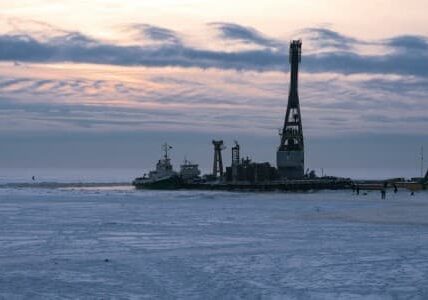Three oil tankers are preparing to meet in the Arctic waters of the Kara Sea, marking the opening of the navigation season along Russia’s Northern Sea Route. Two Aframax tankers, carrying 730,000 barrels of Urals crude, are heading from Baltic ports in Russia to Rizhao, China. A third empty tanker is traveling in the opposite direction, having started its voyage from the Chinese port of Yinkou. This route significantly reduces travel time from Russia’s Baltic ports to refineries in northern China, and more Russian crude carriers are expected to make similar voyages in the coming months, potentially with the assistance of ice breakers.
The empty vessel, SCF Baltica, accompanied by the nuclear-powered ice breaker Sibir, left southern China on June 27, bound for the Russian port of Kozmino on the Pacific coast. Instead of returning to China after loading ESPO grade crude, as most tankers do, SCF Baltica ventured northeast, passing Sakhalin Island and Japan before entering the Arctic Ocean through the Bering Strait. Once in the Arctic, the tanker was joined by its ice-breaking escort and proceeded west along Russia’s northern coast. After a 10-day journey from the Bering Strait, the ice breaker will meet the Primorsky Prospect and the NS Arctic, approximately 170 miles east of Novaya Zemlya island and 250 miles north of the Yenisei River mouth.
The Primorsky Prospect has been waiting at the rendezvous point since Sunday, and the NS Arctic is expected to arrive on Tuesday morning. The Sibir is likely to turn back east and accompany the two fully-loaded tankers through the icy waters to the Bering Strait. SCF Baltica will continue its journey to the Arctic port of Murmansk, where it is scheduled to arrive on Wednesday evening to take on its next cargo of Russian crude.
Owned by Russia’s Sovcomflot PJSC, the tankers are not the newest in the fleet, ranging in age from 13 to 18 years. However, all of them are rated to operate in icy conditions. Using the Northern Sea Route can reduce travel time from Russia’s Baltic ports to northern Chinese refineries by up to two weeks, or about 30 percent, compared to the route around Europe through the Suez Canal and Strait of Malacca. However, only vessels with an ice rating of Ice3 or below can use the route between July and the end of November.
As access to much of the world’s tanker fleet is limited due to sanctions, saving time on oil deliveries to key markets like China and India becomes crucial for Russia. More Russian crude is expected to be transported through the Arctic in the following months, potentially in small convoys with ice-breaker assistance. However, the availability of escort vessels may limit the volume. Russia currently has three modern escort vessels to guide tankers through the Arctic, and they are likely to be in high demand.



